Saul Steinberg the Continuous Miner the Continuous Miner by Saul Steinberg
Category: All posts
loading...
A Cinderella Study for Big Princesses

While we all get swept up in the happily ever after notions of today's fairytale characters, it's important to break open the concept of being a "princess" and widen the definition of what that might look and feel like for girls, both young and old. For deep within these tales are valuable lessons to be learned that go way beyond finding your prince charming.
My first year of teaching was in an amazing kindergarten classroom. We were very fortunate to have a guest teacher come to our class once a week over a period of time to introduce the children to a Cinderella Study. I watch watched, captivated each week, as Karen Balliett, shared Cinderella stories from around the world and lead thought provoking discussions about the universal commonalities as well as the cultural twists among them.
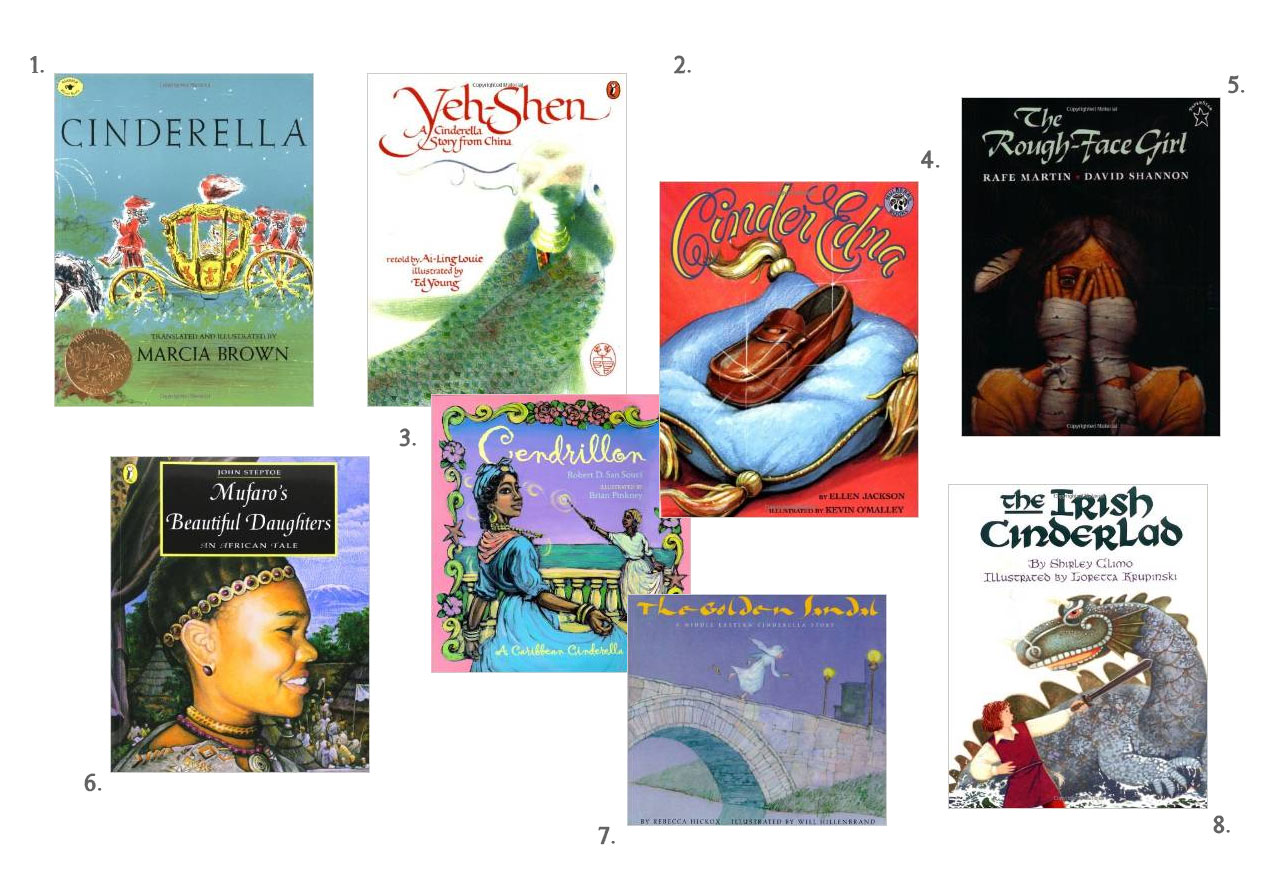 1 / 2 / 3 / 4 / 5 / 6 / 7 / 8 /
1 / 2 / 3 / 4 / 5 / 6 / 7 / 8 /
Years later, the time was ripe for sharing the Cinderella Study with my daughters' book club and it turned out to be a great experience! We gathered our favorite versions of the Cinderella tale (see above).
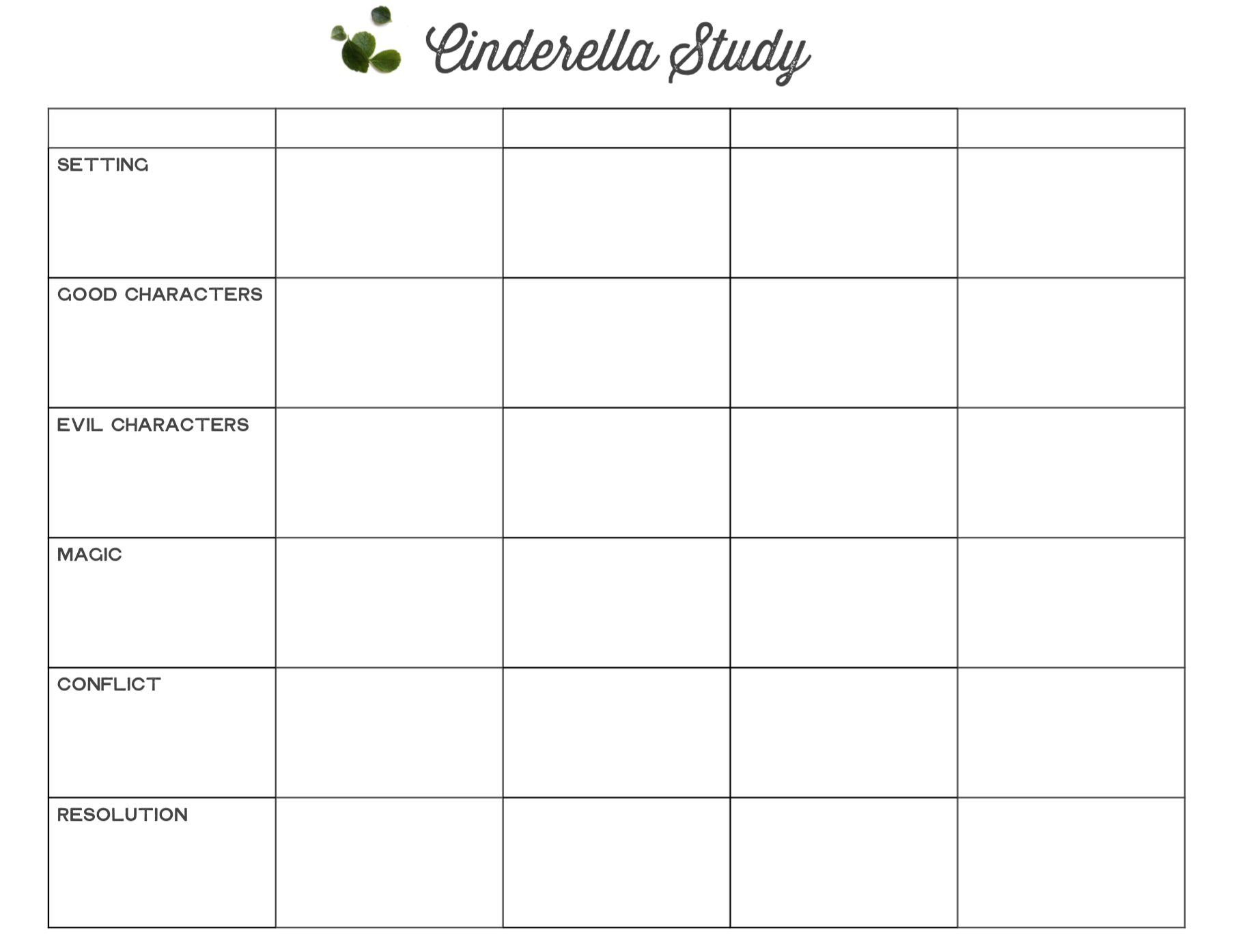
Everyone had their own copy of the printable above and we started out by introducing the elements of story. Once the girls knew what each term meant, we read the different versions and took notes on each one. As we read, the girls started to notice different nuances in the story.
In some of the stories Cinderella had to look beautiful every time she saw the prince, in others that was not the case. In some versions the Cinderella figure marries the prince and in some she does not. In the versions where Cinderella does marry the prince, in some of them she shows forgiveness to her step-mother and step-sisters and in others she does not. Where the magic shows up and what is required to access it differs from tale to tale as well. The possibilities for discussion are endless!

Once we finished our exploration we took some time to draft notes on our own Cinderella stories, which then led to final writing pieces. By the time we got to writing our own stories there was not moment of hesitation as each girl new exactly what they wanted to write. We ended with a lovely author share, as we munched on carrot sticks and hummus, and eagerly waited to hear each other's inspiring tales…
Printables
- Cinderella Study
- My Cinderella Story
A Charley Harper Scavenger Hunt

Our world is full of opportunities to learn and discover something new if we keep our minds open and experience new things. It is also essential to show this concept to the children in our lives.
Last summer, I was able to attend an amazing concert and light show called Lumenocity (see below for a clip from a YouTube video).
This was a phenomenal experience where art, music, and technology were combined! The show featured a local artist that was new to me, Charley Harper. I was stunned that I had not heard of this artist before, especially with his local ties. After the program, I was hooked on his artwork. I immediately came home to search for more information and view more of his works. I was also excited to share this new to me artist with my daughter. Charley Harper's works are so playfully perfect for children and she was able to see how enthusiastic I was about learning something new.
Charley Harper was an American Modernist painter who specialized in wildlife artworks. Capturing his subjects with a minimal amount of visual elements, he illustrated many books and created many prints and posters. I love the clever titles for his artworks and their simple, yet beautiful depictions:

Headbanger, Slumber Party, Good Lovin' and Turtle Dovin' (all pictures courtesy of © 2015 Charley Harper Art Studio)
Art and nature certainly go hand in hand! I decided to combine the two in an activity to get children moving outside, appreciating art and nature all at the same time. Using the artwork of Charley Harper, I have created a fun spring scavenger hunt. Use this printable to go on a nature walk and see how many of these creatures you can discover. I hope that this activity will open your eyes to the beauty of spring and lead to new interests and activities around your house, just as experiencing a new artist has done for me.
If you get hooked on Charley Harper art like me, check out the Charley Harper Art Studio to see more of his works. If you are looking for a mindful gift for someone in your family they have an outstanding selection of children's products. We have two puzzles at our house, and I have my eye on some of the books, sticker sets, and coloring cards.
Are We Imposing a Glass Ceiling on Our Children?

As a society, we tend to underestimate the potential of children. As educators, we are trained to adhere to developmental models, and as parents, we feel the pressure to check off a predefined list of specific milestones at each age and stage of development.
Although these behaviors are natural for parents and educators who are striving to do everything they can for their children, they may at times (often unwittingly) impose limitations on our expectations. This narrowly defined focus may cause us to miss out on other signs of growth, insight (and possibly brilliance) from our children. As our children get older, the checklist becomes even more standardized when they move into a one-size-fits-all educational paradigm.
Although understanding the milestones of child-development is important, perhaps we should pose some questions…
- Do they prevent us from noticing and nurturing other traits, characteristics, or strengths that are equally important?
- Do they on some level, impose a glass ceiling by predetermining what children are and are not capable of?
- Do they on a subtle level, cause us to dumb down our language, responses, and expectations of our children based on this "common knowledge?"
- Do they lead us to believe that children are only considered capable if they process and demonstrate their understanding in predetermined ways?
Observant parents and educators realize that there is much more to children than meets the eye. Children are inherently driven to actively investigate and make a positive impact on the world around them. When presented with stimulating and engaging experiences, children intuitively take full advantage of the opportunities to learn. It's up to us as parents and teachers to encourage children to tap into their potential by nurturing these internal processes.
Maria Montessori once said:
"The child is endowed with unknown powers, which can guide us to a radiant future. If what we really want is a new world, then education must take as its aim the development of these hidden possibilities."
― Maria Montessori
Loris Malaguzzi, founder of the schools in Reggio Emilia, Italy, agrees about the untapped potential of children:
"All people, and I mean scholars, researchers, and teachers, who, in any place have set themselves to study children seriously, have ended up by discovering not so much the limits and weaknesses of children, but rather their surprising and extraordinary strengths and capabilities, linked with an inexhaustible need for expression and realization."
― Loris Malaguzzi
By realizing that children possess hidden potential that may exceed our narrowly defined expectations, we can make a more concerted effort to help them unleash it.
However, this DOES NOT mean pressuring children to read by age five. Shifting the content of a third-grade curriculum to a fourth-grade level and claiming to have raised "standards" is not the solution.
Too often, current school curricula do not leave much room for exploration, investigation, or at times, even questions. Combine that with mandated, high-stress, high-stakes tests, that are written to confuse and trick children, and teachers who are being evaluated based on those scores—and you have a recipe for disaster. Not only are we placing a glass ceiling on our children, we are tying the hands of our most gifted and talented teachers.
Have you noticed an increase in your child's level of anxiety related to performing in school? Does your young child already feel as if they can't keep up academically? Is this how we intend to inspire the next generation of children to live into their potential? Given the recent cognitive research that shows how stress inhibits meaningful learning, I hardly think so.
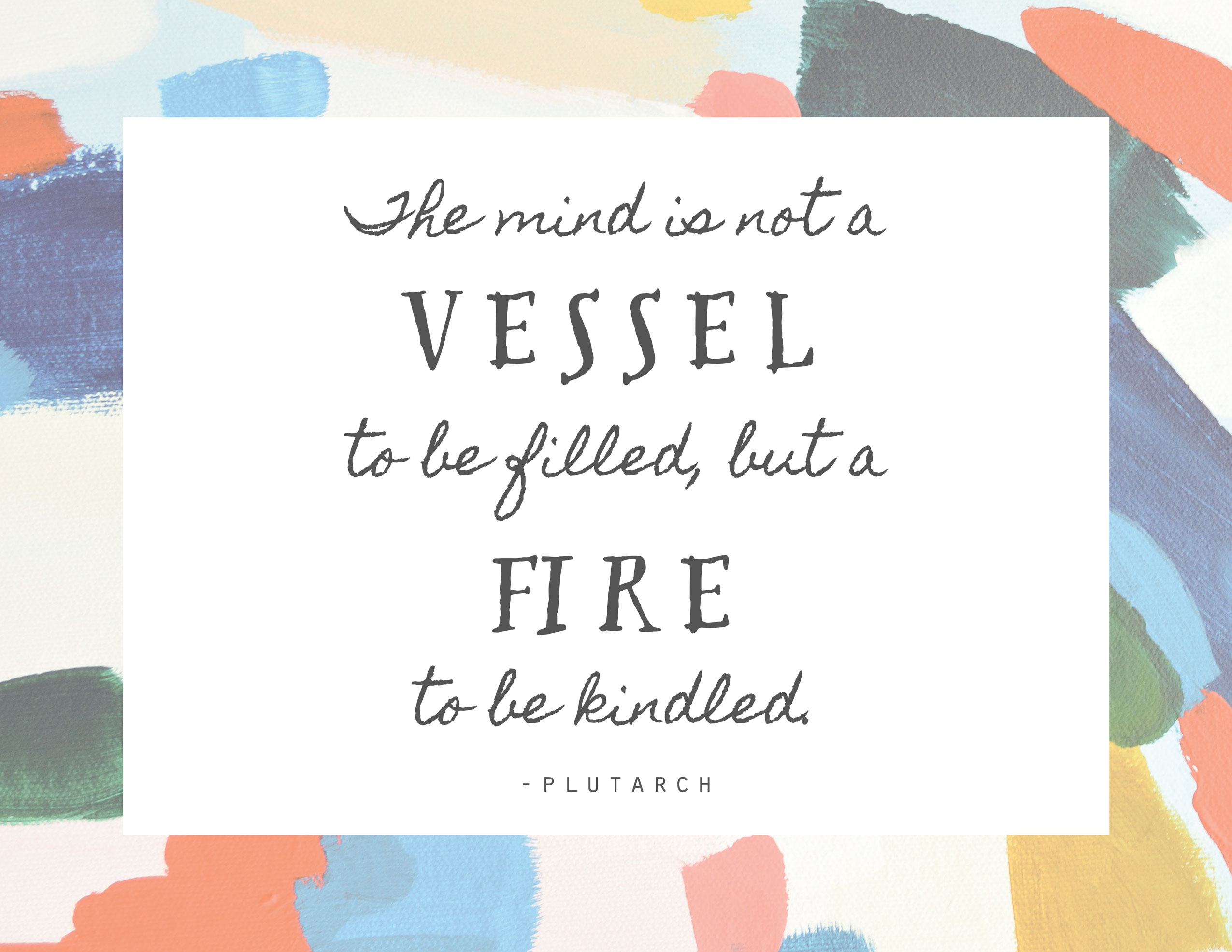
What if Maria Montessori was right?
What if children are capable both intellectually and emotionally of far more than we as a society ever allow them to reach or express?
What does that mean for us as parents and educators? As a society, are we placing our resources, talent, time, and energy in the right places?
The good news is that as parents and teachers, we can tune in and do little things that can make a big difference for the children in our lives…
Connect
Find little moments to slow down and be fully present with your child. Let go of expectations, set plans, or preconceived ideas of how this time will go. Be present with your child and follow their lead. Listen intently and make suggestions based on an interest they express. Pick-up on one of their ideas and run with it. This shows the children in your life that their questions deserve answers, their thoughts are interesting, and their ideas are worthy of coming to fruition.
Free Time
With so many facts and skills being squeezed into the school day and more pressure to cover greater amounts of data, one of the best gifts that grown-ups can give their children is time to discover and pursue their personal passions. For it's the endeavor that is chosen approximately 10 minutes after the infamous "I'm Bored…" declaration that shows you where your child's true interests lie.
Tune Into Your Expectations
If given the support, children will rise to our expectations. It is up to us to constantly check in with ourselves about what we are really expecting. If we are tired of seeing a certain behavior in our children, we need to make sure that we are not actually looking for or setting them up for that behavior.
On the other hand, when we really believe that our children are capable of doing something, more often than not, they do. Hold the picture of them being respectful, treating their siblings kindly, sharing their things, or whatever your goals are for them, clearly in your mind. Then, speak to them, treat them, and respond to them as if they are on their way to achieving that goal. When you really believe that your children are capable, then the inevitably slip-ups, simply become teachable moments.
There is nothing more exciting than when our children surprise us with their brilliance, insight, and creativity. Let's give them every opportunity for them to show us their best selves…
Resources for Teaching Kindness
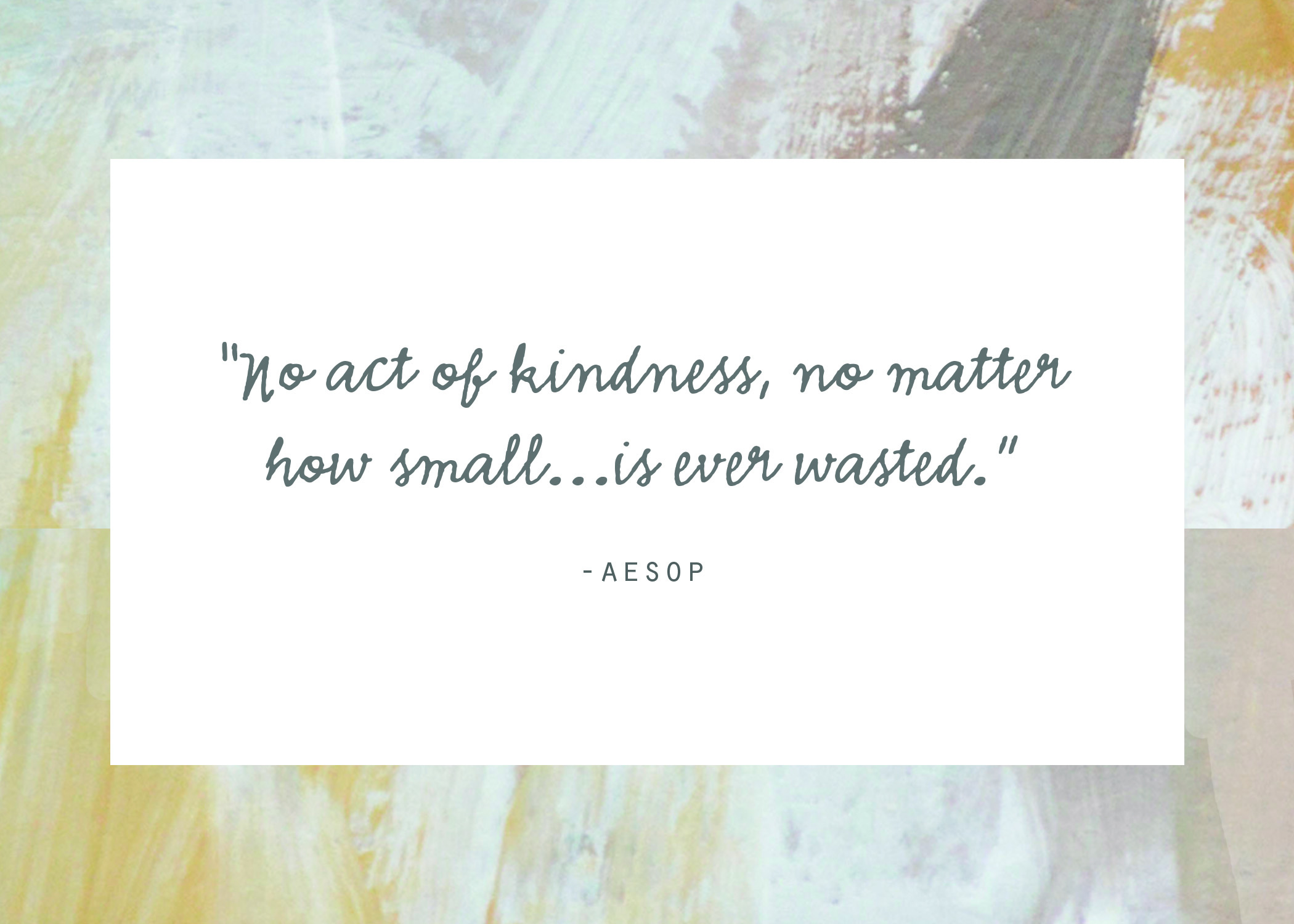
Kindness. It's truly one of the simplest ways to connect with one another. It can be exchanged through a smile, a wave, a handwritten note, or a hug. Kindness doesn't need to cost anything, and it doesn't have to be extravagant.
Growing up, my mother always told me to be kind and that it pays to be nice. When I was young, I knew that you should hold a door for someone, take a moment to smile and say hello, and offer help to those who look like they may need it. I grew up believing that you should go out of your way to care about and be thoughtful of others, from all walks of life. Now, I'm doing my best to impart that same simple wisdom onto my daughters. I tell them they should always say please and thank you and that gifts (no matter how small) should be followed up with a note of appreciation. I tell them that each of their classmates deserve kindness, even if there comes a time when one of those classmates isn't kind to them. We talk about empathy and taking time to really think about other people's perspectives. I explain to them the importance of including others who look like they may need a little extra compassion. When my girls leave in the morning for school, I always tell them "Be good to your teachers, and be good to your friends." They are learning that those few words have great and powerful meaning behind them.
Teaching our children to be kind, compassionate, generous, and appreciative is perhaps one of the greatest gifts we can give one another. I believe that it's our responsibility as adults, role models, leaders, parents, and educators to not only teach these behaviors to the next generation but also to model them ourselves.
Here are a few resources to help all of us share more deliberate kindness in the world.
The Random Acts of Kindness Foundation
www.actsofkindness.org
The Random Acts of Kindness Foundation is a non-profit organization that is dedicated to encouraging kindness in homes, classrooms, and communities. Their website is overflowing with free resources as well as ideas for how to spread kindness like volunteering at a community garden, donating old books, writing a poem for someone you love, or simply saying good morning to a stranger. In addition, you can read about and share your own stories of kindness. This site is truly an invaluable resource.
Teaching Tolerance
http://www.tolerance.org
Founded by the Southern Poverty Law Center, Teaching Tolerance helps teachers and schools fight prejudice, promote equality and celebrate diversity. I have used many of these lessons year after year in my elementary classroom. Be sure to read about the national campaign, Mix It Up, a Teaching Tolerance initiative that encourages students to step outside of their comfort zone and get to know someone new at lunch. Mix It Up inspires students to make connections and develop relationships with classmates across social boundaries. This can be easily adapted in the classroom as well.
The Kindness Journey
http://thekindnessjourney.com/resources/
This website follows twelve-year-old Jaden Winn and his mother Amanda as they embark on a yearlong journey across the United States. Their main goal is to educate and inspire people along the way to join in the #kindnessmovement while raising funds for Life Vest Inside, an organization dedicated to uniting the world with kindness (http://www.lifevestinside.com). If these two don't move you to spread the love, I'm not sure what will!
Picture Books that Promote Kindness
- Each Kindness by Jacqueline Woodson
- The Invisible Boy by Trudy Ludwig
- The Lion and the Mouse by Jerry Pinkney
- Because Amelia Smiled by David Ezra Stein
- Mufaro's Beautiful Daughters by John Steptoe
- Extra Yarn by Mac Barnett
Chapter Books that Promote Kindness
- Wonder by R.J. Palacio
- Because of Winn-Dixie by Kate DiCamillo
- The Hundred Dresses by Eleanor Estes
- Charlotte's Web by E.B. White
Finally, use the printables below to spread more kindness in your home, classroom, or community. What will your deliberate acts of kindness be?
- Quote
- Kindness Cards
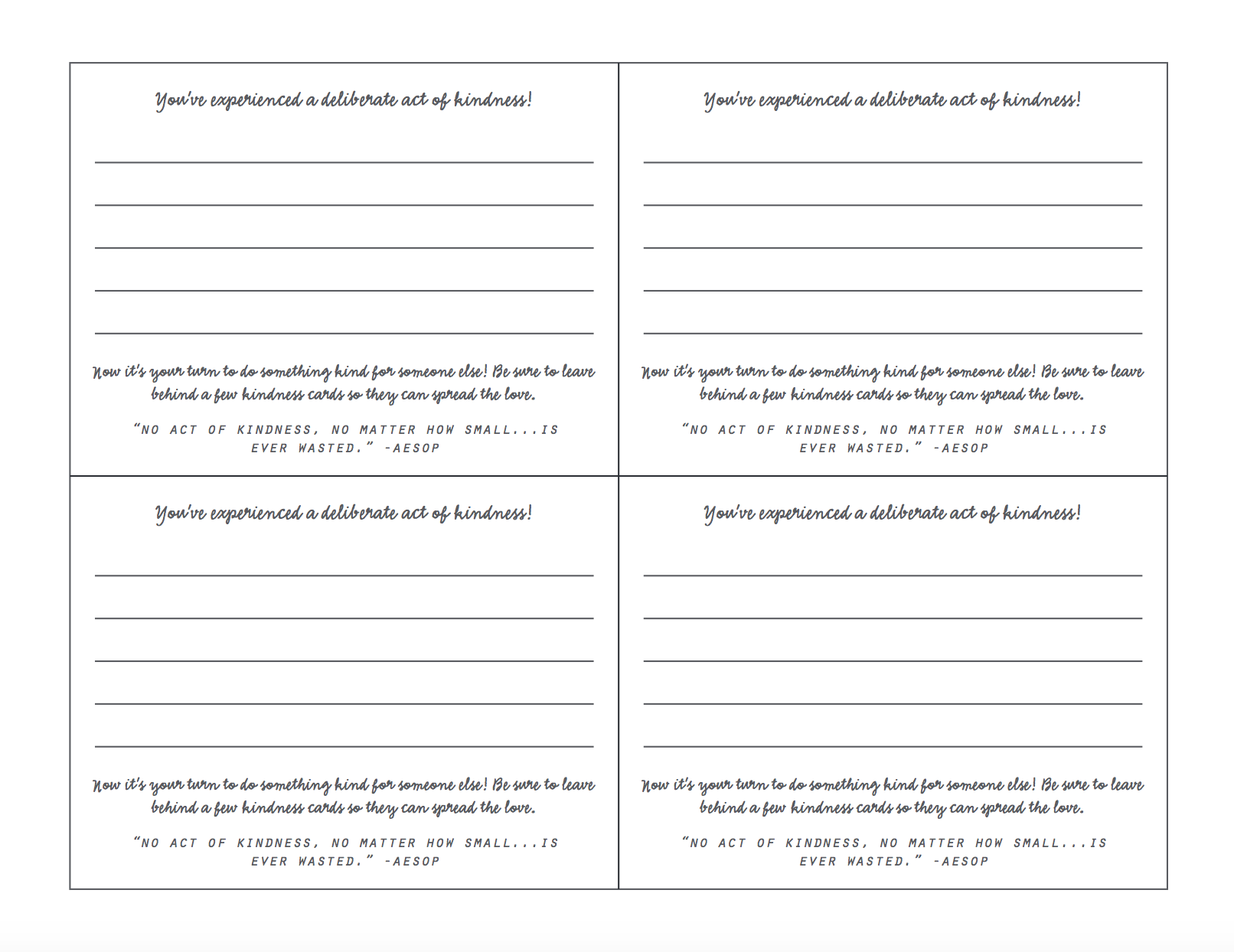
* This post contains affiliate links
Flower Print + Scrape Painting
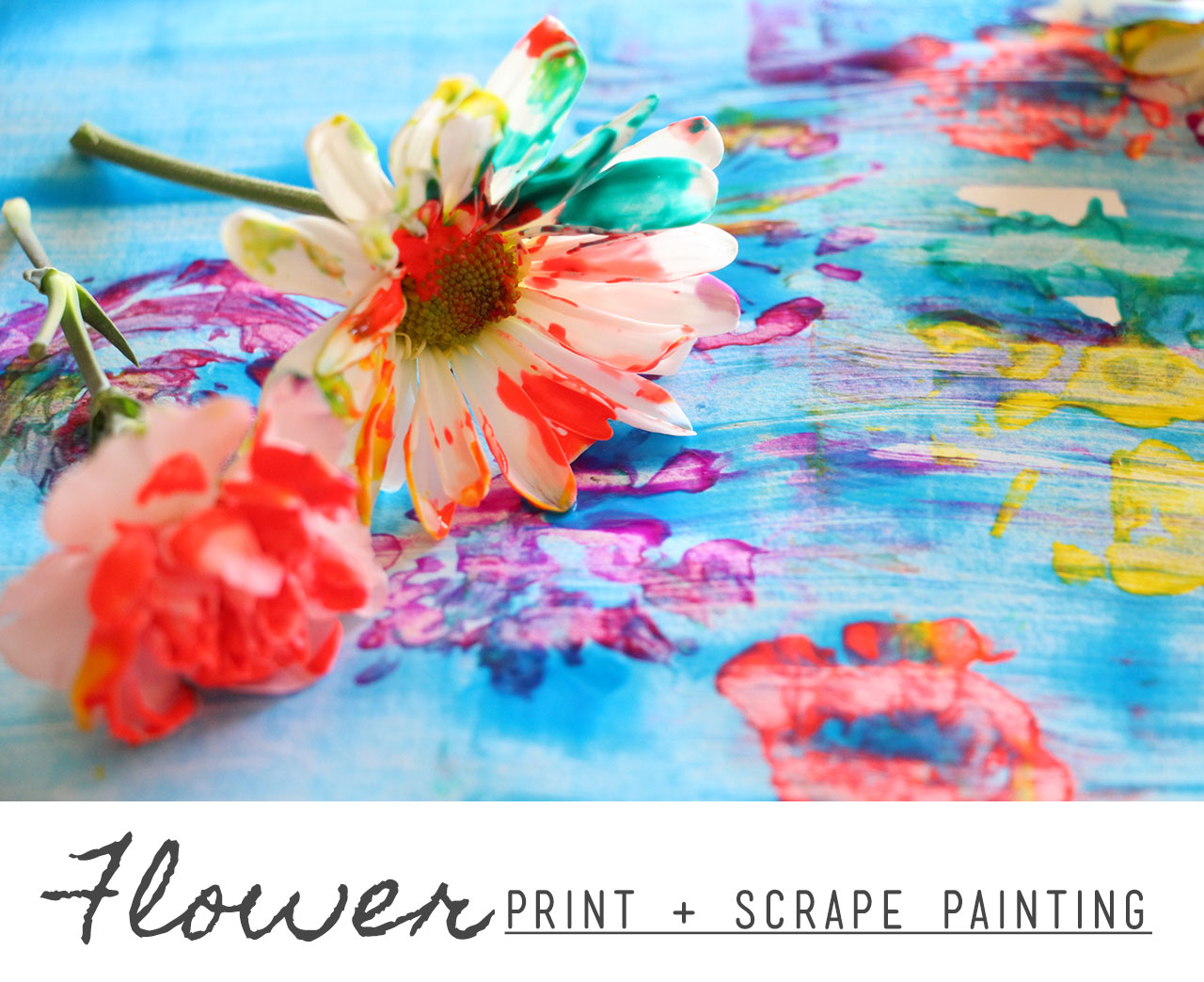 With blizzards, cold fronts and low temperatures blanketing much of the country, spring and its promise of warm days and flowers poking up through the ground seems far, far away. But with a simple art project, you can magically create spring inside, no matter how cold it is outside! Read on for a fun painting project and art history extension.
With blizzards, cold fronts and low temperatures blanketing much of the country, spring and its promise of warm days and flowers poking up through the ground seems far, far away. But with a simple art project, you can magically create spring inside, no matter how cold it is outside! Read on for a fun painting project and art history extension.
Supplies:
- Table covering
- Heavy paper (watercolor or cardstock)
- Paint (I really like Biocolor paint)
- Paper plate
- Fresh flowers
- Ruler
This project can get messy, so cover your work area with newspaper, butcher paper, or a disposable table cloth.
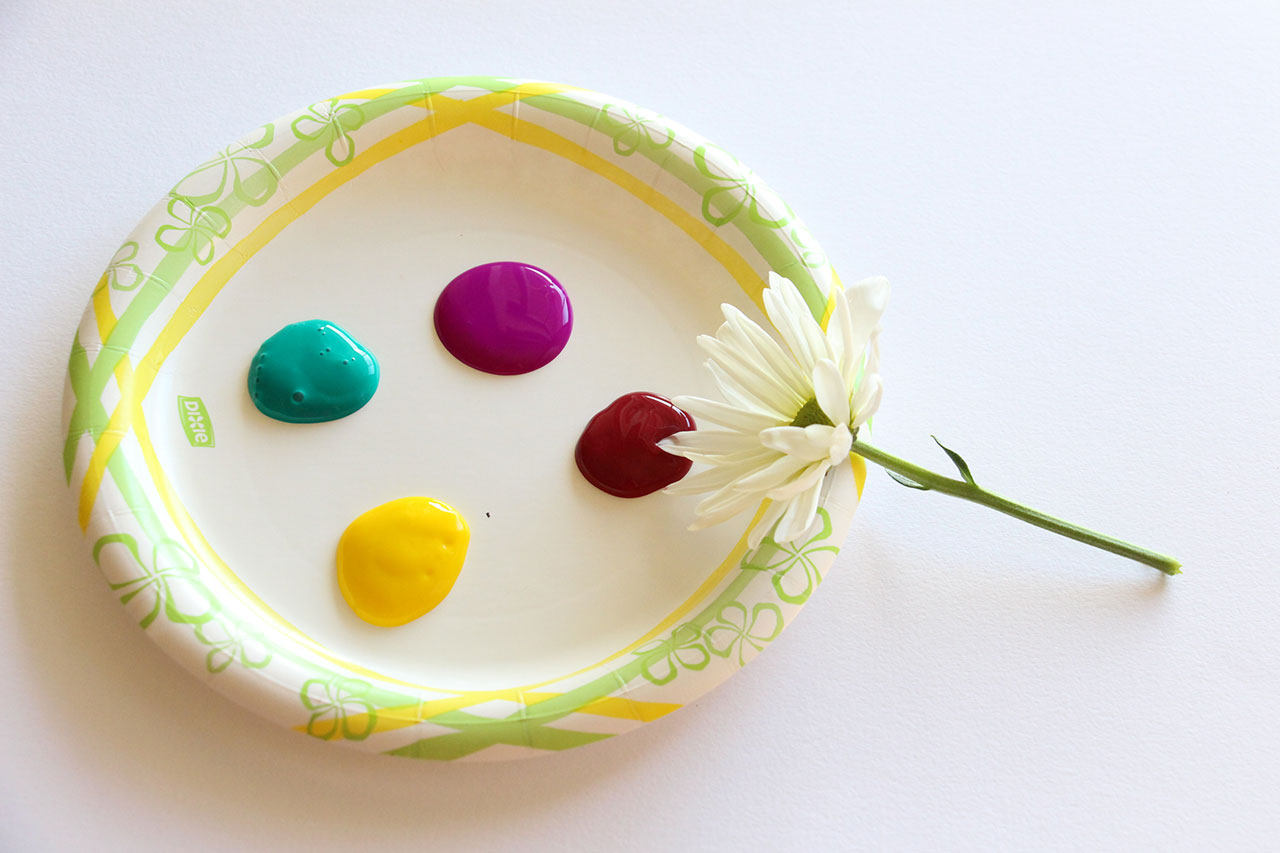
Squeeze blobs of paint onto the paper plate, leaving plenty of room to press the flowers down into the paint. Now it's time for flower painting fun! You are essentially replacing your paint brush with a fresh flower, so dip the flower into the paint, then gently press onto your paper.
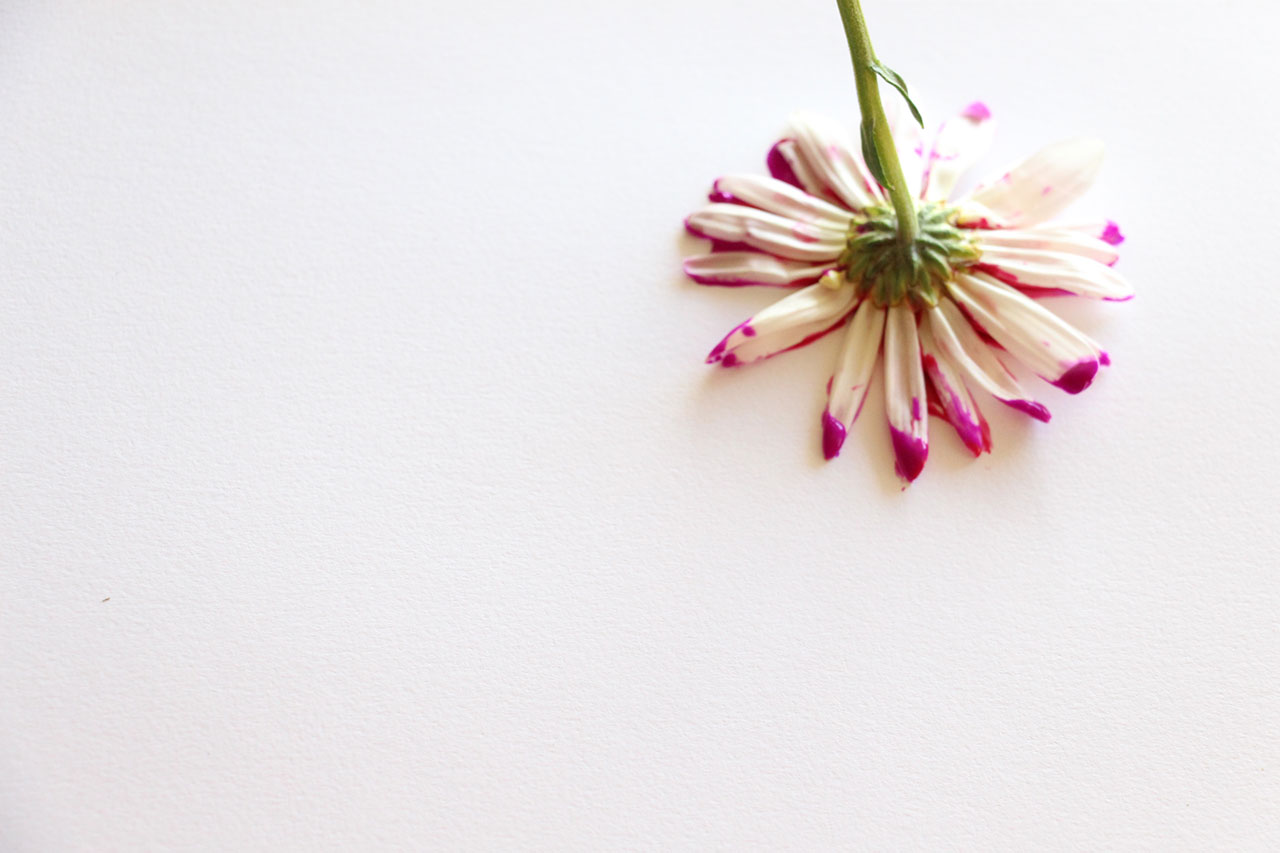
Experiment with mixing paint colors and using differently shaped flowers as you cover your paper with flower prints.
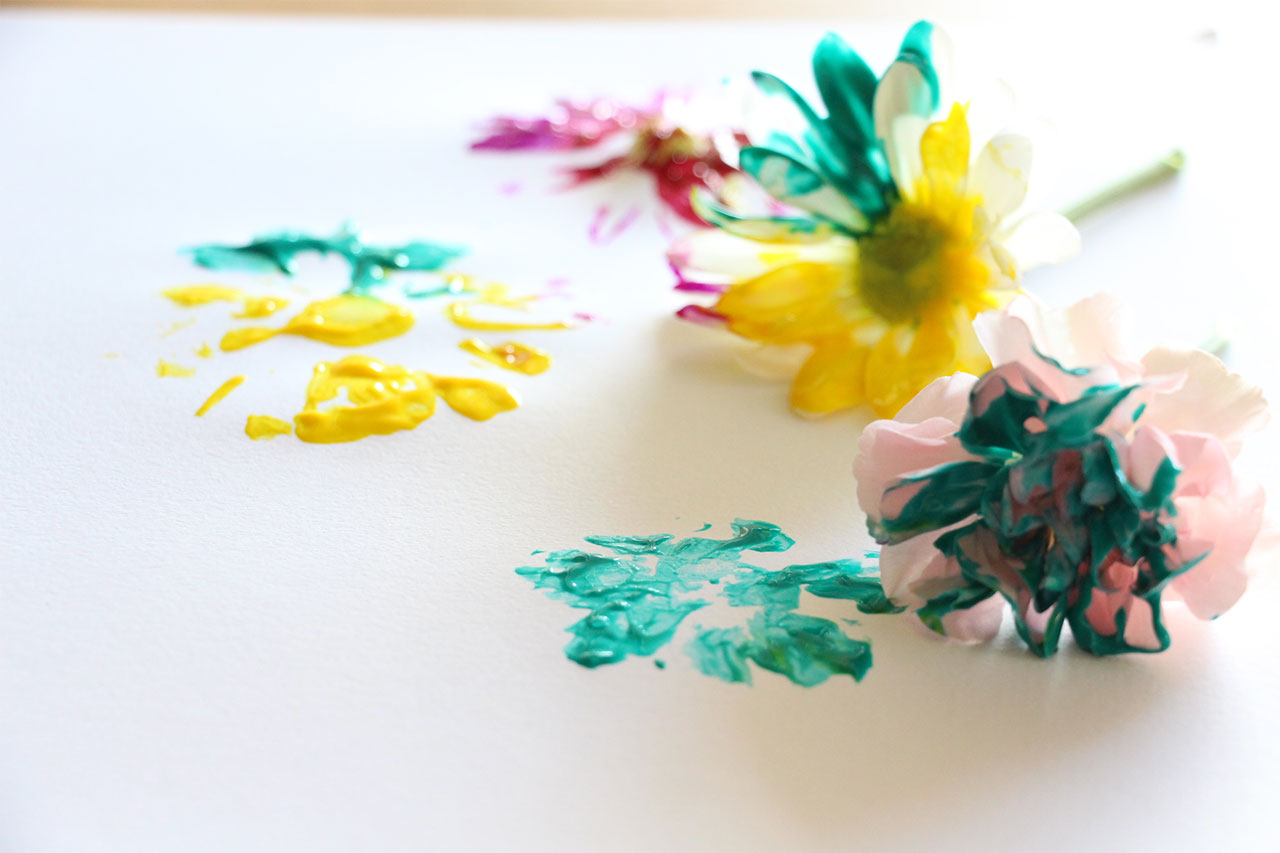
Don't worry if petals or other parts of the flowers get stuck in the paint—that just adds fabulous texture! Show your child how to twirl the flower back and forth in a circular motion to create a different type of mark. Younger children may also enjoy brushing the flower across the page just like they would with a paint brush.
Once your masterpiece is complete, set aside to dry.
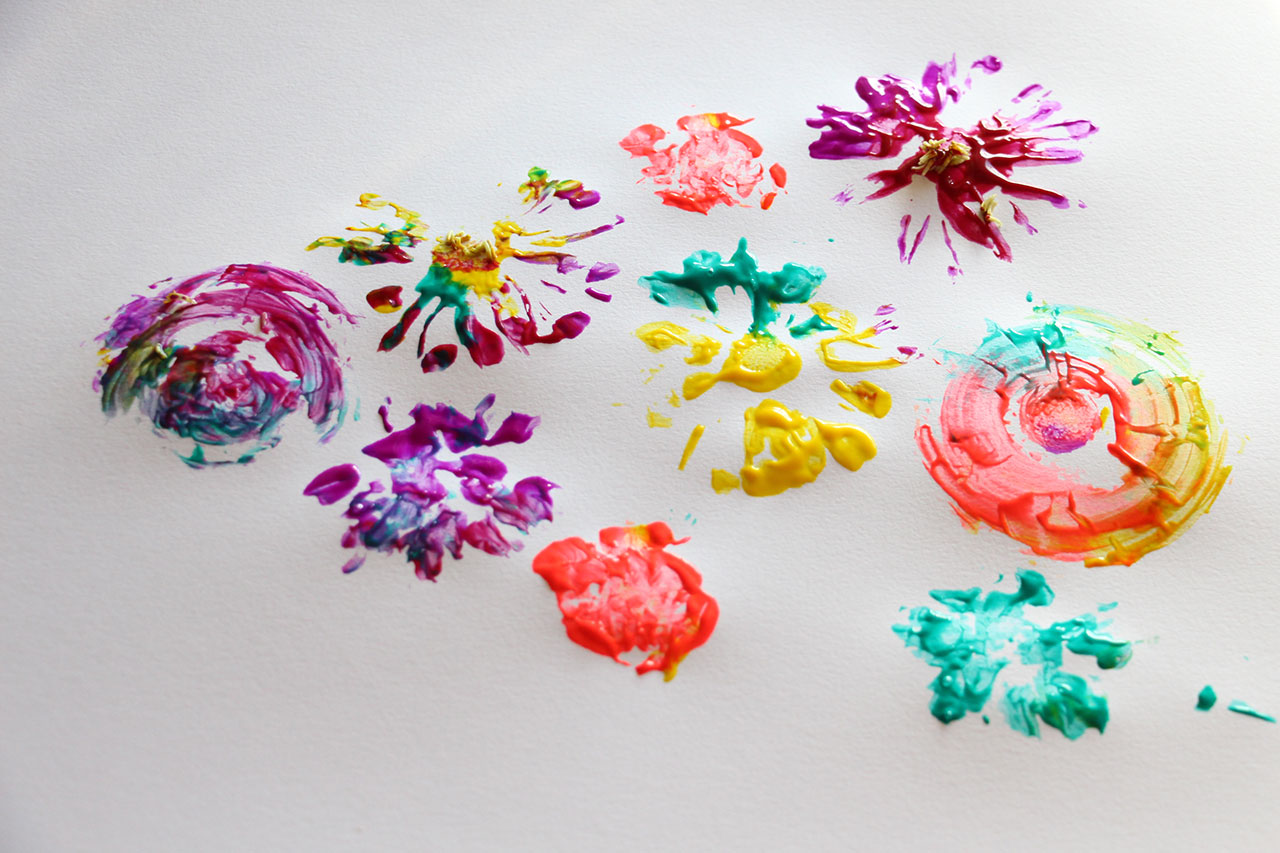
Extend the painting fun and enjoy an easy teachable moment by introducing your child to the Impressionist paintings of Claude Monet. Towards the end of his life, Monet focused almost entirely on painting the water lilies in his garden pond, creating paintings that make the viewer feel as if he or she is gazing down into the water. Read a picture book about the artist to learn more about his life and work. Some of my favorites include: Philippe in Monet's Garden by Lisa Jobe Carmack, Where is the Frog?: A Children's Book Inspired by Claude Monet by Geraldine Elschner, Katie and the Waterlily Pond by James Mayhew and The Magical Garden of Claude Monet by Laurence Anholt.
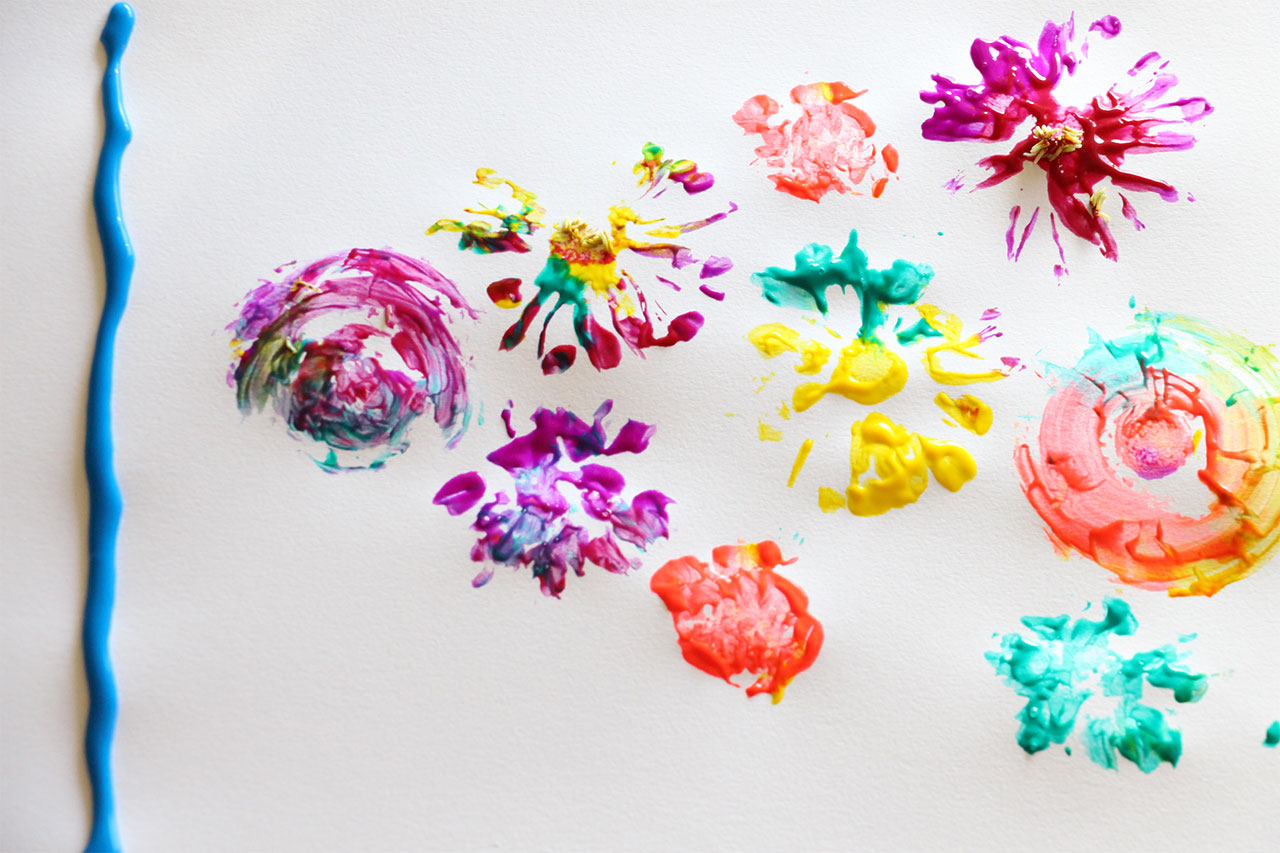
To transform your flower painting into a Monet-inspired work, you only need some blue paint and a ruler. Squeeze a line of blue paint along the far left edge of your painting. (Left-handed children might find it easier to manipulate the ruler if the paint is squeezed on the right edge of the painting).
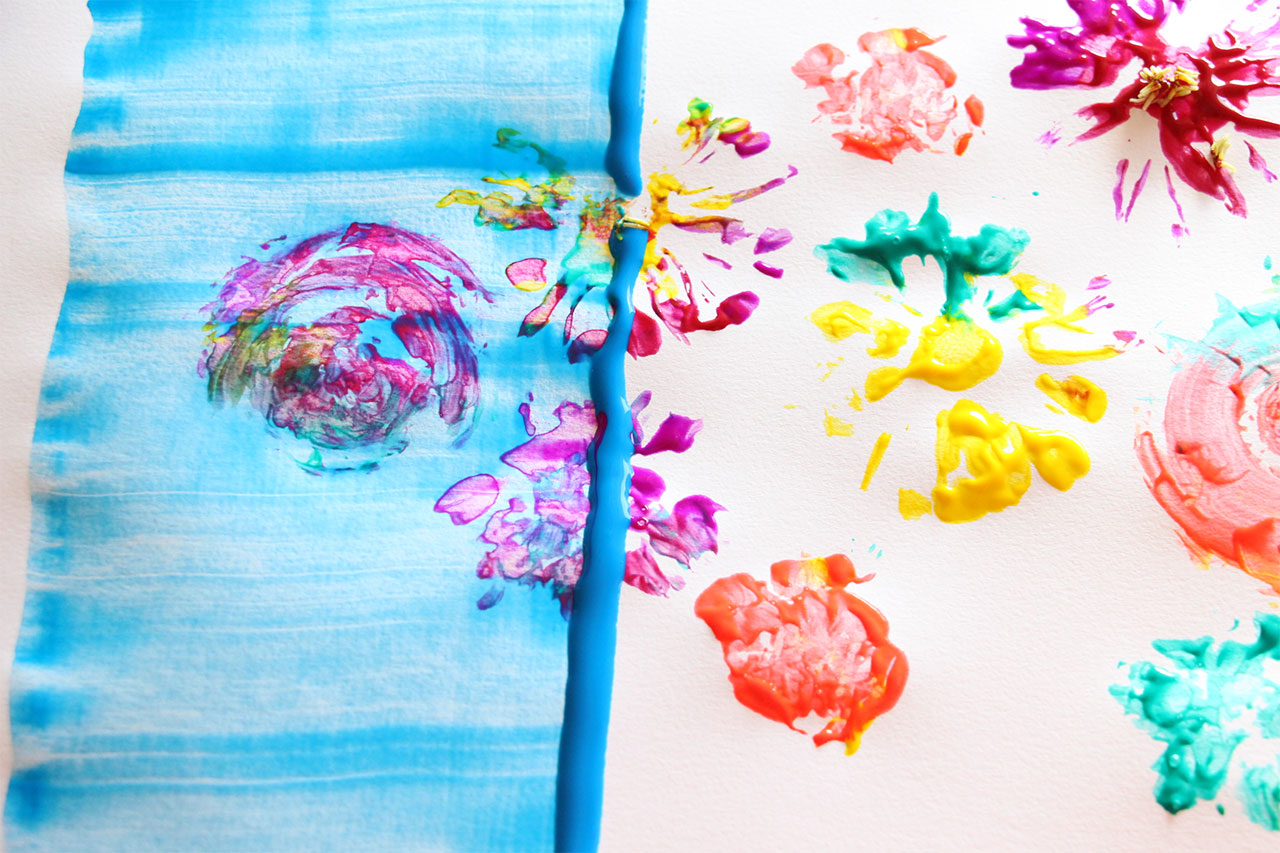
Use the ruler as a scraper, and drag the blue paint across the paper.
If needed, add additional lines of paint in the middle of your artwork so that you can completely cover the paper with blue paint.

I love the effect the scraper makes, smearing the flowers and creating a beautiful impression of rippling water—just like Monet! Experiment with how wet or dry your flower prints are before scraping paint across them (in the above painting, my flowers were not that dry at all, and you can see in the upper right how much of the flower smeared).
For more Monet-inspired art-making ideas, take a look at this Pinterest board with suggestions suitable for toddlers to teens! Or, if you're ready to hang up your artist's smock, channel your inner scientist and use any leftover flowers for this fun Dissecting Flowers lesson.
Secret Kindness Pals

February is an ideal month to start a new trend in your home or classroom… Secret kindness pals create excitement and add warmth through kindness to the classroom.
Begin with Literature
To begin our exploration of kindness, I start by reading aloud. I have found that literature provides the perfect introduction and helps weave ideas together for students. The short chapter book entitled, Horrible Harry and The Green Slime by Suzy Kline shares a story of a classroom where the teacher chooses to give her class secret pals. The first time I read this book to a class I had a student ask if our class could have secret pals. I said "yes" for many reasons and one of them being that the timing was perfect. It was very close to Valentine's Day and Random Acts of Kindness week had just started.
Literature Links:
- Horrible Harry and The Green Slime by Suzy Kline
- Each Kindness by Jacqueline Woodson
A Week Filled with Kindness
Our kindness week is filled with excitement as students think about different ways to be kind to their secret pal and to others. We create lists with simple ideas to spread kindness: hold the door for someone, help another student get their book bag out of their locker, draw a picture, write a poem, bake some banana bread, and many more. We draw pictures for our secret pal making sure to include colors, activities or people he/she enjoys. We discuss how being kind feels and how it feels to be the receiver of a kind act.
Conclude with A Clue Poem
I ask students take part in writing clue poems about themselves to conclude and reveal our secret pals. Each student composes a poem with ten clues about themselves. Students also write the name of their secret pal but not their own name on the top. This way we do not know the writer but do know who it is for. I then read each poem aloud, tell the class who the secret pal is and we all try to guess who wrote the poem. When we figure out the writer, he/she then delivers a special Valentine's box to his/her secret pal.
A Personalized Surprise for our Secret Pals
I often choose to conclude our mini-unit on the day of our Valentine's party for the simple reason that my students can make a Valentine's collection box for their secret pal. You could easily conclude on a different day with a different type of simple gift. I ask students, as a family homework activity, to create a personalized Valentine's box for his/her secret pal. Students know their secret pal through our classroom community but I also have each student fill out an interview about him or herself describing their favorite places, people, activities, etc. This information is passed along to their secret pal. This way he/she can add personal touches to drawings, poems and the Valentine's box. The results are often beautiful and varied ~ as students really think about their pal and his/her interests.
Website:
- https://www.randomactsofkindness.org
All Natural Fizzy Bath Bombs

It's mid-February and there is something in the air, something floating like tiny wisps through the heart shaped ether. That's right, it's snow. Well it is where we live anyway. Snow, snow and a bit more snow. So it's appropriate that this month, the month in which love is celebrated in all it's shocking pink, chocolate flavored glory, that we take a little time to show one another some real love and care.
Where we are, in Eastern Canada, winter is long and can feel a bit grueling. By February the novelty of the snow and cold has worn off and we are all longing for spring, but spring is a little way off yet. But that doesn't mean we can't indulge a little and find ways to feel warm and cozy in the mean time. It's a great time for candle lit baths, snuggles by the fire and time to give our dried out skin a little extra love.
My two farm boys love nothing more that a good soak in the bath, so this seemed like a great time to add a little extra fun with some heart shaped fizzy bath bombs. Of course I want their bath to be cozy and good for them, so these are made with natural ingredients that will help keep their skin from drying out after snowy adventures outside. I made my fizzies with chamomile tea, to help battle colds and aid relaxation; you could use peppermint tea, lavender or just plain water, all should work well.
The ingredients are all items you may well have in your pantry, and any mold that you happen to have will work too. The only special item is citric acid, but that is easily found at home brew stores or your local Bulk Barn. If you feel like theming your bath fizzles, you can add your favorite essential oil to the mix. Personally I prefer to add the oils neat to the bath for a maximum hit of goodness, do what works best for you.

Chamomile Bath Fizzies
You will need:
- 1 cup of baking soda
- 1/2 cup of citric acid
- 1/2 cup of corn starch
- 2 table spoons of Epsom Salts
- 2 1/2 table spoons of Coconut Oil
- 3 Table spoons of cold chamomile tea (you could use a different tea, witch hazel or just plain water)
- Up to 10 drops of essential oils such as lavender, chamomile or geranium. All of these oils are suitable for children.
- 1-2 drops of food coloring (optional), I used 1 drop of red to get a pale pink color.
If you have a mixer this is ideal, if not use a wooden spoon or whisk to mix the ingredients thoroughly. Mix the dry ingredients together and then add your oil. The mixture should become crumbly, make sure the oil is evenly distributed.
Next add the liquid, mix slowly and carefully. There will be a little bit of a fizz on contact but if you keep the mixture moving it should be minimal and the moisture will be absorbed quickly. The mixture will take on the texture of damp sand, once this happens stop adding liquid.
Press your sand like mixture into your molds, this is when you will know if you added too much moisture! If the mixture begins to fluff up it won't set, my original batch was too wet and did just this. Luckily you can still add it to the bath and enjoy.

Leave the mixture in your molds overnight to dry. I used heart shaped candy molds and they worked perfectly. You don't need to coat them with anything, once they are dry they will pop straight out.
These fizzies are perfect to gift to friends or simply to use yourselves, adding a little extra warmth and fun to a cozy, winter bath time.
Snowflake Math

Anytime learning can be rooted in the world around them children thrive. This is true for mathematics-based explorations, just as it is for science and history. Right now snow, lots and lots of snow, surrounds my children.
There are many activities that can be done with snowflakes that enhance children's mathematical understandings.
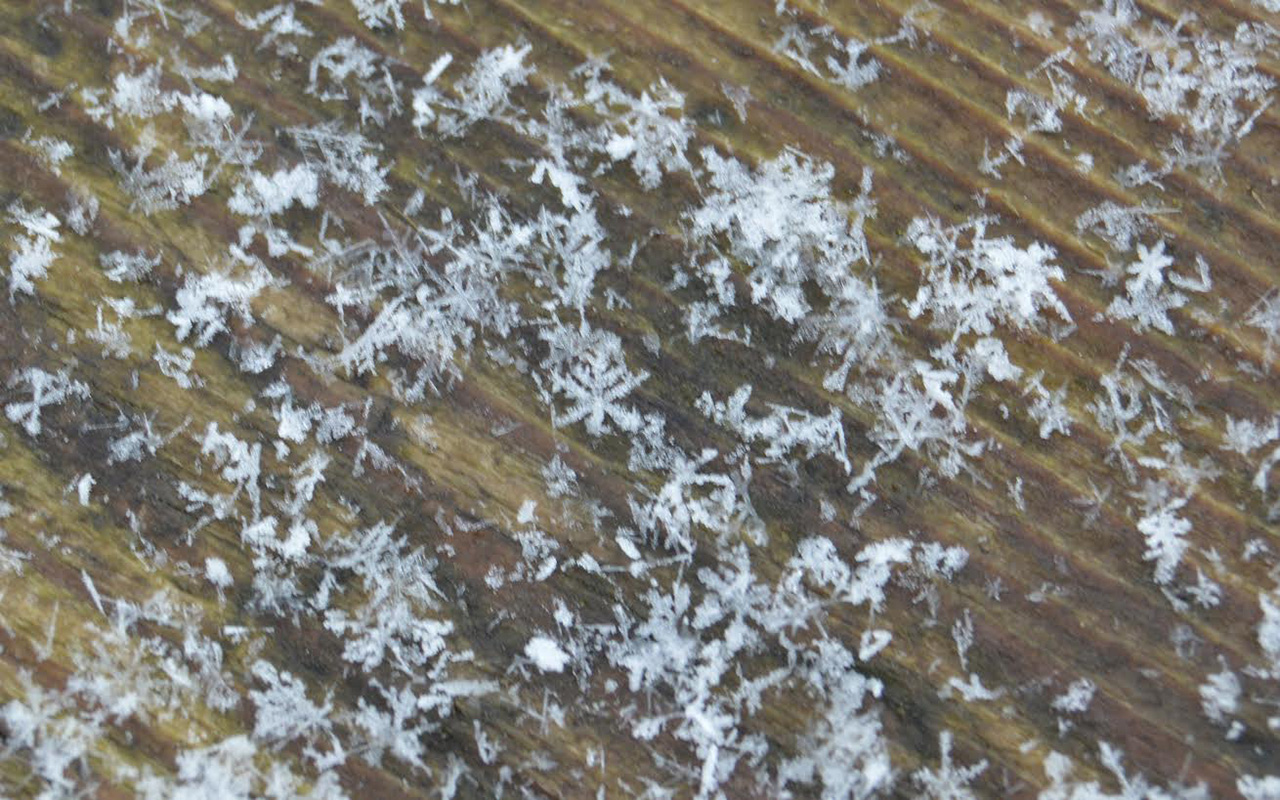
First, if you can, observe snowflakes outside; watch them fall, catch them on a gloved hand, or on black paper, and observe them with a magnifying glass or a camera zoom. With older children you can try a snowflake fossil technique. If the weather is not cooperating with you look at snowflake books or pictures of snowflakes. When observing the snowflakes ask your children questions such as, "How many sides does your snowflake have?" "Do all of the snowflakes we see have the same number of sides?" "It's said that no two snowflakes are exactly alike, but can you find any that are similar?"
Next make paper snowflakes, there are many methods for making paper snowflakes, but one of the simplest methods starts with round paper coffee filters and a pair of scissors, appropriately sized for your child. First have your child fold the filter in half. Then count the "valleys" in the filter. Our coffee filter halves had 12 valleys. We knew we wanted to fold this piece into thirds so we divided 12 by 3, arriving at 4. This told us we needed to have each section have 4 "valleys". Now fold the half-moon filter into 3rds, using these "valleys" as a guide. Finally fold the filter one last time. You have essentially folded the coffee filter into 12 pieces, but after cutting you will be left with a six-sided snowflake.

If you are folding snowflakes with older students now might be the time to take out a protractor.
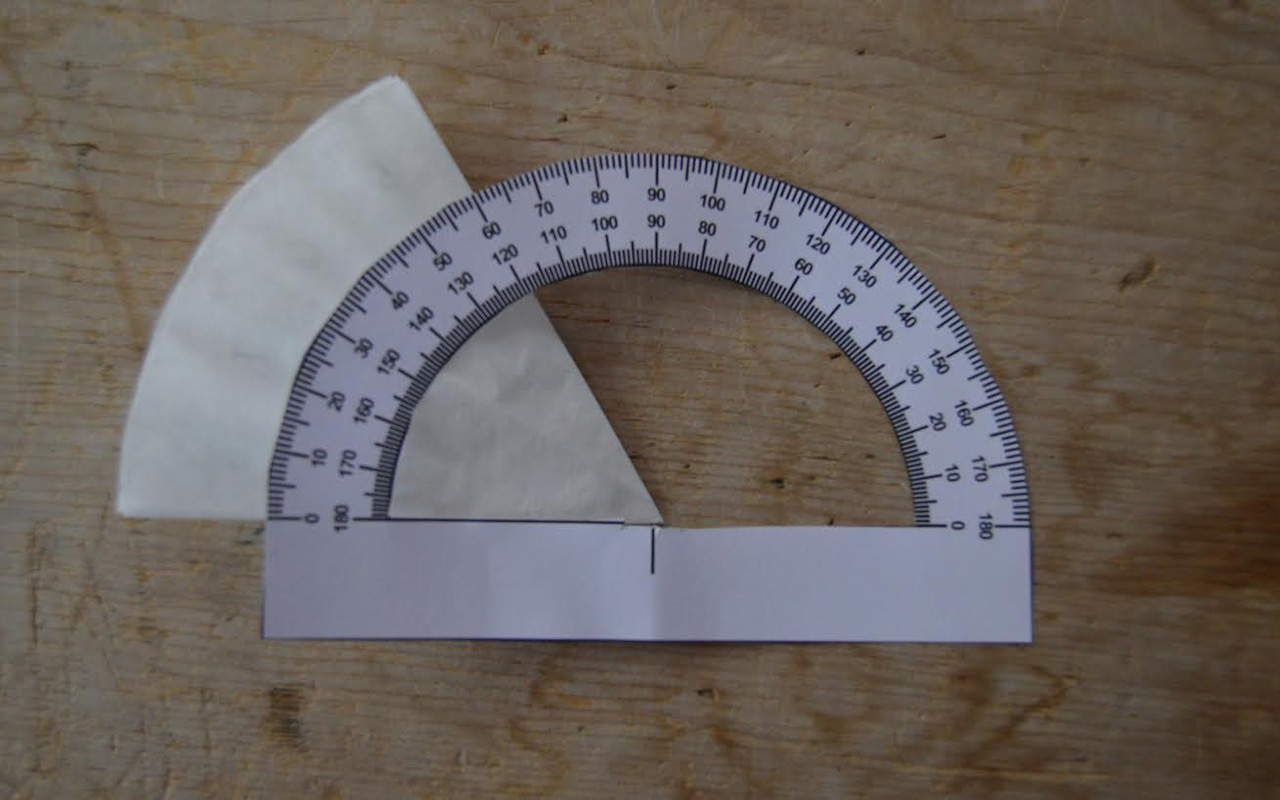
Instead of counting the "valleys" in the filter and using a division problem to decide where to fold you could instead try to figure out the angles you will need to create. Present questions such as, "If the paper snowflake is a circle and therefore 360 degrees, how many degrees will the angle be when we divide the circle into sixths?" "Into twelfths?"
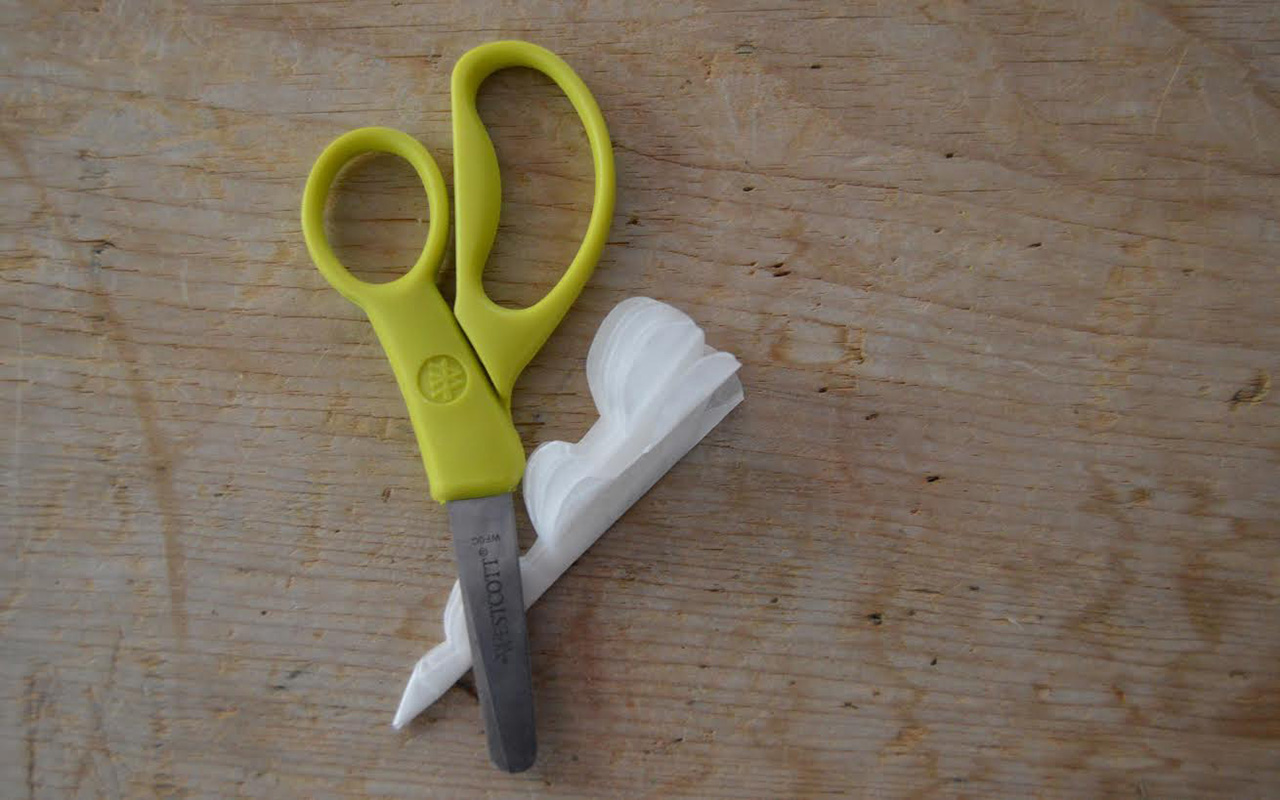
Now cut out your design making sure not to cut all the way through the folded edge.
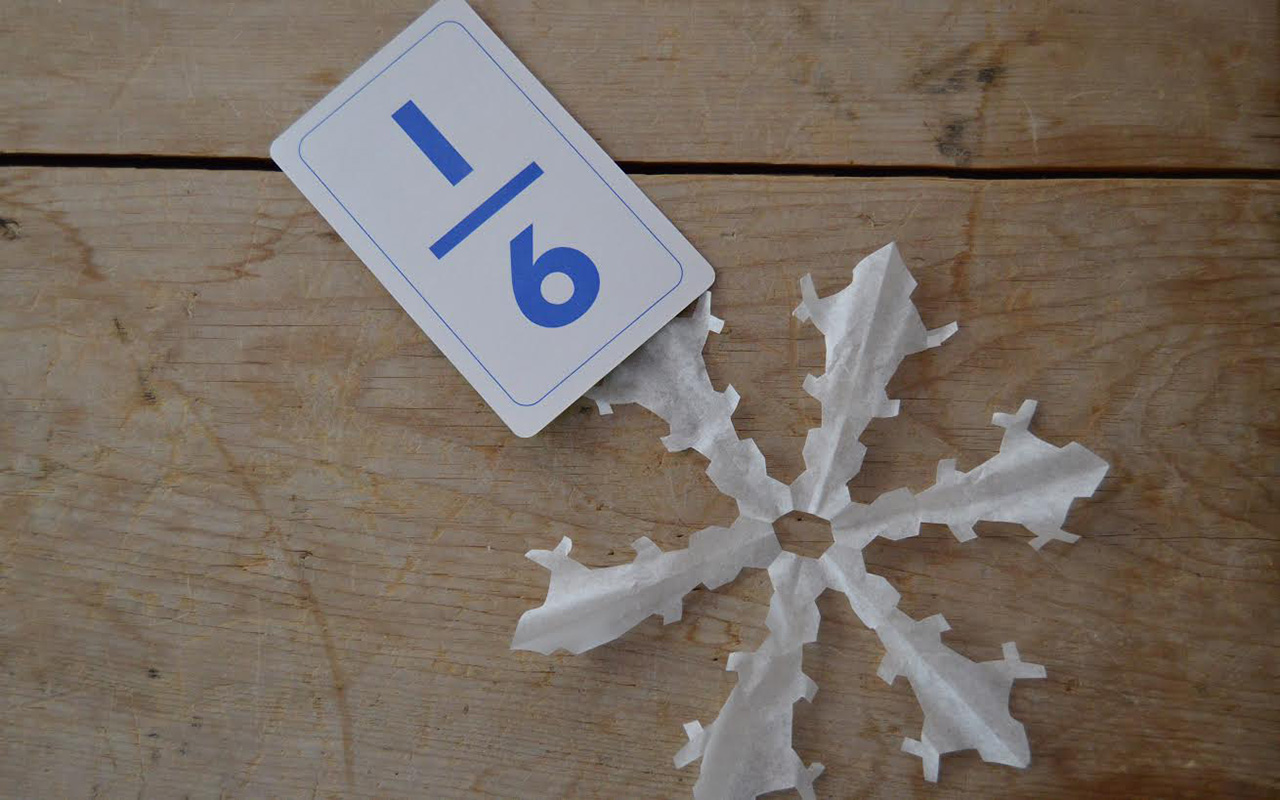
Snowflakes also lend themselves to discussions of fractions. When you observe snowflakes in their natural setting it is very rare to find some that is completely intact. They have taken quite a ride to get to the ground and often have broken branches. You can observe what fractions of the branches are broken.

Symmetry is another mathematical concept that can be reviewed when observing snowflakes. Leaving aside the damage that can happen to a snowflake while it falls, snowflakes form in a symmetrical manner. Each snowflake starts as a hexagonal prism and since each arm of the flake forms under the same weather conditions each branch will be identical. After creating their paper snowflakes children can find the lines of symmetry by reviewing their folds, or using a straight edge, or pencil, to mark them.
Math really is all around us, especially in those little flakes currently falling outside my house!
Zen and the Art of Classroom Maintenance
 Each classroom has a rhythm. For my fourth grade class, the stretch from winter until spring break develops a rhythm that can only be described as challenged. I have tried to figure out the reason, but it is proving difficult to locate the culprit. Some fourth grade teachers who have been doing this teaching thing for quite some time will tell you that the students come back as completely different individuals after winter break. No reason, just some intuitive and magical neuron that all fourth graders possess. I wonder if it is me as I become increasingly aware of the testing that is right around the corner. There also seems to be some intuitive and magical neuron in every fourth grade teacher that begins to demand product after product to make certain everyone has the greatest chance for success. All of these products and assessments seem to have the direction attached that they must be produced by the end of the period or end of the day. This unsurprisingly does not leave much time for student reflection, editing or ownership. Some days I think I am making them despise school and the fundamental right to enjoy learning. To help everyone involved (including my sanity), I introduce a project that focuses on process.
Each classroom has a rhythm. For my fourth grade class, the stretch from winter until spring break develops a rhythm that can only be described as challenged. I have tried to figure out the reason, but it is proving difficult to locate the culprit. Some fourth grade teachers who have been doing this teaching thing for quite some time will tell you that the students come back as completely different individuals after winter break. No reason, just some intuitive and magical neuron that all fourth graders possess. I wonder if it is me as I become increasingly aware of the testing that is right around the corner. There also seems to be some intuitive and magical neuron in every fourth grade teacher that begins to demand product after product to make certain everyone has the greatest chance for success. All of these products and assessments seem to have the direction attached that they must be produced by the end of the period or end of the day. This unsurprisingly does not leave much time for student reflection, editing or ownership. Some days I think I am making them despise school and the fundamental right to enjoy learning. To help everyone involved (including my sanity), I introduce a project that focuses on process.
At the front of the room, during our regularly scheduled math or language arts block, I stand with a handful of black pens and large white paper. I then introduce them to Zentangle. Zentangle is a drawing method with websites and blogs dedicated to it. This is the original site run by the creators of Zentangle, Maria Thomas and Rick Roberts. We discuss the importance of having a project that might take more than a week to complete. We talk about letting go of exactly what you want as a finished product and just to focus on the moment as you are drawing. Then, each table group gets a sample sheet of different patterns that they could use somewhere in their design if they would like. Not all students choose to access these, but they are nice for the reluctant Tangler. The agreement is that for early finishers in other work and during down time in the room, their Zentangle can be a project they may choose to work on throughout the day. The kids love the choice and the freedom in this project. There is no due date and the only constraints are the edges of the paper. I love the quiet calm that descends on an otherwise busy and overly scheduled day. I love it so much, that I have added fine-point Sharpies to the fall supply list. I also have taken up the habit of drawing with them…I call it modeling. The pieces of art that are eventually produced are strikingly unique and could only belong to their individual creators. When a parent drops by, they are quickly shuffled by their student to their desk so that they can unroll their project and share the evolving work. Each year when I pull out the drawing paper and my stash of Sharpies, I know that our rhythm is going to get righted just a little bit more.

Included for you, as a very special parting gift, but really just for sticking with me through my monologue of classroom hiccups, are two printables to get you started. A little collection of patterns inspired by Zentangle and created by my students as well as a blank template based on artist Saul Steinberg's "Continuous Miner". This is a great printable to use with younger children or for the parent/teacher who is better than me and actually attempts to integrate art history and design principles into projects. Filling out a template is probably very frowned upon in the Zentangle community (it exists), but I say, if it gets someone interested, give it a try…or maybe a Tangle.
A Book List for Animal Lovers
 We thought it would be fun to share a list of our favorite books for all of the animal lovers out there…
We thought it would be fun to share a list of our favorite books for all of the animal lovers out there…
1. Animalium by Jenny Broom. If I was giving out awards, this book would receive my Best Book of 2014 award! It's Magical, whimsical and ever so engaging for everyone. It is the most perfect book for pleasure and research and marries both areas ever so perfectly. It is also a large format book (370 x 272mm), which makes it that extra bit special. My schoolboy received this as his end of school year gift (In Australia we have school years according to the calendar year). My son is inquisitive and has a thirst for new information. He adores David Attenborough and therefore Animalium was the perfect gift for him to help foster the love of the world around us. Animalium is the first in a series of virtual museums published by Big Picture Press and I long to find out what the next piece in the collection will be. Each chapter features a different part of the tree of life and poses so many questions. Schoolboy and myself talked and talked about what we thought the differences between a plant and an animal are. What a brilliant project to explore with your child. Our suggestion is to start with reading the opening pages and choosing a part of the tree of life to focus on: flightless birds, frogs and toads, colorful birds, the possibilities are endless. Go on to sketch, research, gather, touch, create…
More to Explore…
2. Infographics: Animals by Simon Rogers and Jenny Broom
3. Animal Kingdom: Color Me, Draw Me by Millie Marotta
4. Creature ABC by Andrew Zuckerman
5. Bird by Andrew Zuckerman
6. Creature by Andrew Zuckerman
7. World Search: Incredible Animals by Lonely Planet

Source: https://www.playfullearning.net/resource/category/all-posts/page/8/
0 Response to "Saul Steinberg the Continuous Miner the Continuous Miner by Saul Steinberg"
Post a Comment